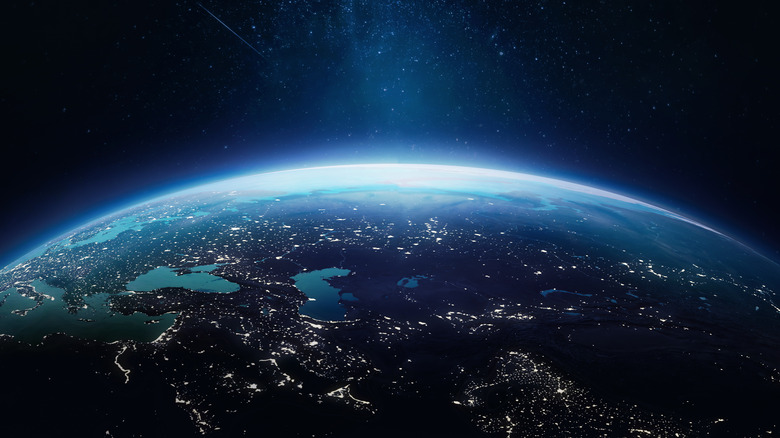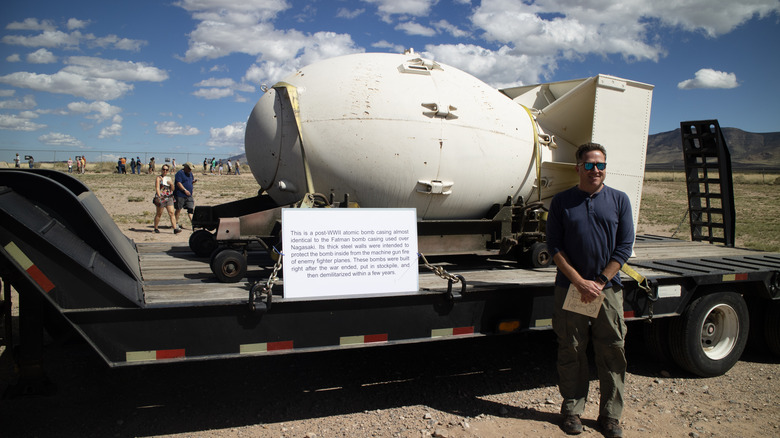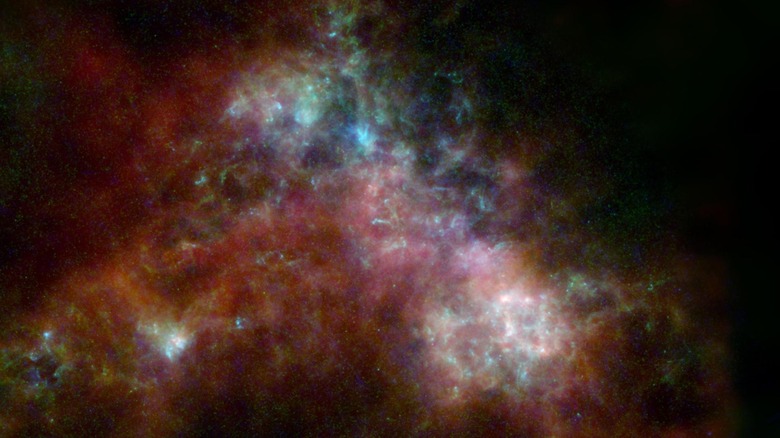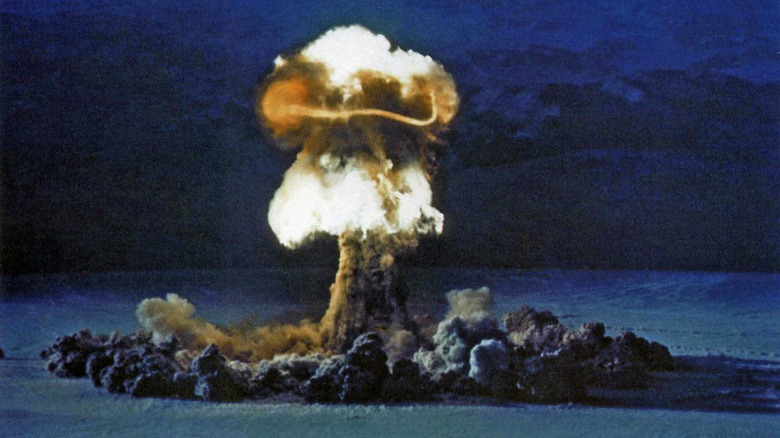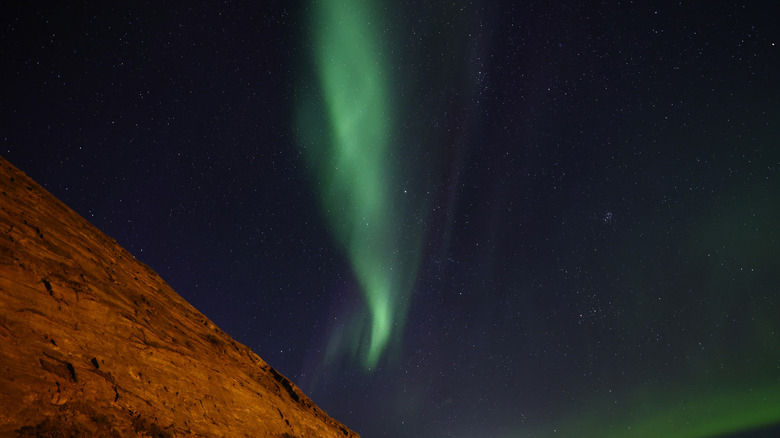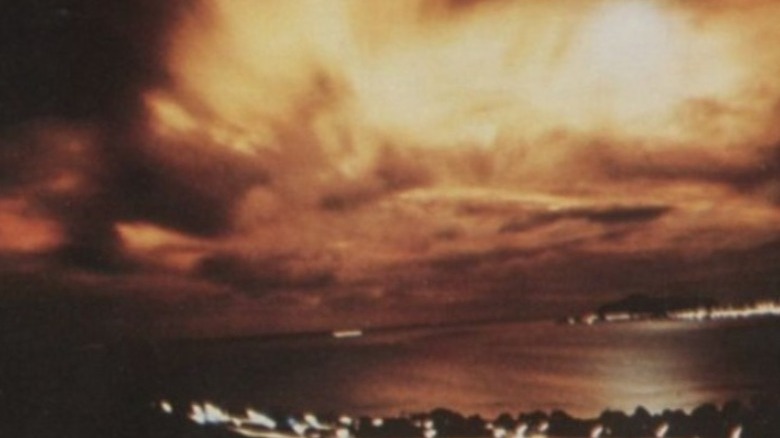Detonating A Nuclear Weapon In Space Is A Terrible Idea. Here's Why
Nuclear weapons are probably one of the most terrifying things ever made by humanity. Most people will be quite familiar with their unspeakable death and destruction, and for good reason. From 1945 to 1996, there were well over 2,000 nuclear bombs tested across many countries, according to the United Nations. To this day nuclear testing continues in several countries, like North Korea. Perhaps there might be a time in the future when nuclear disarmament is possible, and the danger associated with nuclear weapons is eliminated.
To date, nuclear bombs have been used twice in wartime: Hiroshima and Nagasaki (via History). And the largest bomb ever detonated in history was Tsar Bomba. It eclipsed both Fat Man and Little Man, the bombs dropped on Japan during WWII, in blast radius and size, according to Britannica.
With that being said, there are questions about nuclear bombs and their nature, particularly in hypothetical scenarios. For example: Nuclear bombs have been detonated underwater, so what would happen if one were detonated in space?
How nuclear bombs work
Nuclear weapons are the most terrifying invention on planet Earth, but how do they work? Firstly, there's a bit of history to know behind the bomb.
As explained by History, in 1938 Berlin, Germany, scientists discovered something that would forever change the world of physics, World War II, and history as people knew it: Nuclear fission. Nuclear fission is the process that atoms undergo when splitting themselves.
Nuclear fission sounds like a complicated process, but it's actually straightforward. Atoms undergo fission when neutrons slam into them, causing them to split in two. As told by the Office of Nuclear Energy, an enormous amount of energy is released when this happens, which serves as the basis for nuclear bombs. On the opposite end of things, nuclear fusion is what happens when atoms come together, instead of splitting apart. This creates an atom heavier than the two and is behind the sun's energy. Both fission and fusion are processes important for nuclear detonation, but in different ways.
So, a nuclear warhead usually contains isotopes like uranium-235 and plutonium-239, though this can sometimes vary, depending on the bomb. However, nuclear fission and nuclear fusion are the signature processes nukes undergo to produce massive amounts of energy all at once. According to How Stuff Works, when a nuclear bomb is detonated, it rapidly undergoes these processes to create an immense amount of blast energy, heat, and radiation.
How the properties of space work
Space is awesome and terrifying, but many of its mysteries still elude most to this day. There are a few basic things about space, however, that aren't too difficult to grasp. For example, the reason why space is a vacuum.
To clear things up: Space's vacuum is not the same as an ordinary household vacuum. As Live Science says, the vacuum of space means a region almost entirely devoid of anything, including matter. Space is not a perfect vacuum, however, as there are still particles, atoms, and, of course, planetary bodies.
This also means that space has very low pressure. So, if one were to go into space without any protection or spacesuits, their blood, and most of their body, would boil quickly (via BBC). Talk about a gruesome fate.
Another thing about space is its breathability — or rather its lack thereof. Space is almost entirely devoid of oxygen. As Science says, this is because oxygen atoms have a tendency to stay attached to stardust, so they can't join together to form molecules. This is important in regard to detonating nukes in space because it completely changes how their explosions would behave.
A nuclear bomb detonated in space would look different
In a hypothetical situation where a nuclear bomb detonates in space, what would likely occur? One should curb their enthusiasm, as nukes don't work the same way in space as they do on planet Earth.
Nuclear bombs on Earth are able to generate blast waves and mushroom clouds because of the presence of oxygen. Fire and explosions need oxygen to burn, which is why nukes send out massive blasts and shockwaves miles across a region. But in space, there is no oxygen to generate this. Earth's atmosphere is made up of various gases like oxygen, carbon dioxide, nitrogen, and so on, which help keep living things alive (via National Geographic).
As explained by ScienceABC, a nuke detonated in space wouldn't make a mushroom cloud, but more so a spherical explosion. There would still be an intense release of heat and radiation, but the actual blast wave would not follow as it would on Earth.
Nuclear byproducts are the biggest danger
A nuke detonating in space has the effect of creating an Aurora Borealis light show. The Northern Lights phenomenon, as explained by the Canadian Space Agency, happens primarily in the Northern Hemisphere, and is when the sky is lit up with a myriad of vivid colors. Similarly, Southern Lights also occur in the Southern Hemisphere of the planet. Collisions between charged particle ions and gases in the atmosphere cause Aurora Borealis.
So why is this relevant to nuclear bombs? Because the same lighting effect would also happen in a nuclear explosion in space. As Science ABC says, the nuclear blast would produce a lot of charged particles, which would have a dramatic effect on the Earth's atmosphere. The lights would be seen across the world and might even last a couple of days. This of course comes with the atmosphere basically becoming immensely radiated, but at least there'd be a pretty sky for a while.
Such byproducts of a nuclear explosion could also be dangerous. The magnetic field created by a nuclear explosion could disrupt Earth's electronic communications, and debris would funnel into the upper layers of the Earth's atmosphere (per Science ABC). According to BBC's Science Focus, these byproducts are the primary dangers of nuclear bomb explosions in space — as opposed to on Earth, where the blast itself is the threat.
The U.S. once detonated a nuke in space
Detonating nukes in space may seem like a nonsensical, hypothetical idea with no basis in reality, but that's far from the truth. It turns out that the United States actually did just that: detonated a nuke in space, just to see what would happen.
It all started on July 8, 1962. Starfish Prime, the name of a fusion bomb, was launched into space by the U.S. military from Johnston Atoll, where it was visible even 1,000 miles away on Midway Atoll. According to National Geographic, the bomb was about 500 times more powerful than the nuke dropped on Hiroshima. As described by officials at the time, the bomb apparently made the entire night sky burn with red light. The blast was so powerful, that it actually created an Aurora Borealis in the sky, and even people in New Zealand could have seen it that night.
Stakes were high at the time, as the U.S. was competing with the Soviet Union in a nuclear arms race. As a demonstration of power, the U.S. conducted many nuclear tests to prove its nuclear readiness. As said by Smithsonian Magazine, there was very limited knowledge about how radiation worked in space at the time, so the tests also proved useful for science. With that being said, hopefully people will never detonate another nuke in space ever again.
